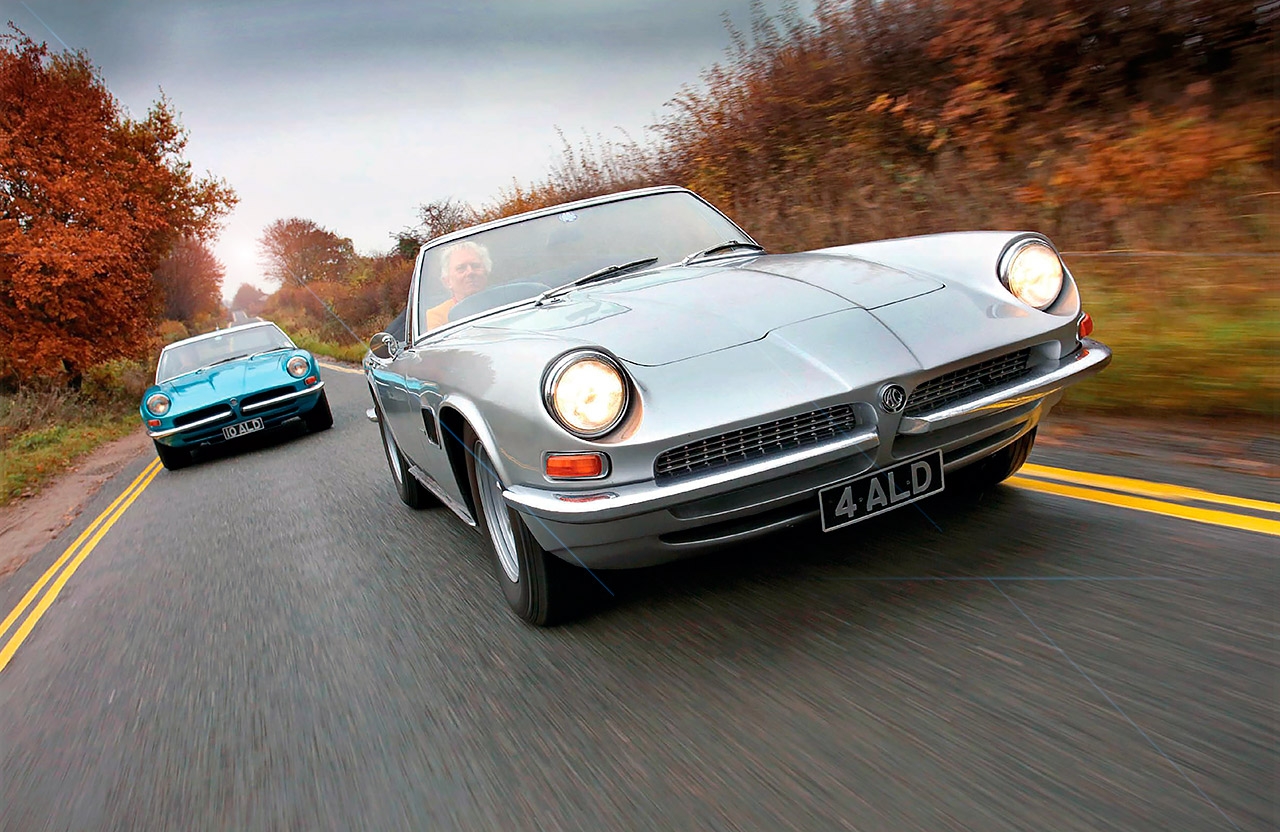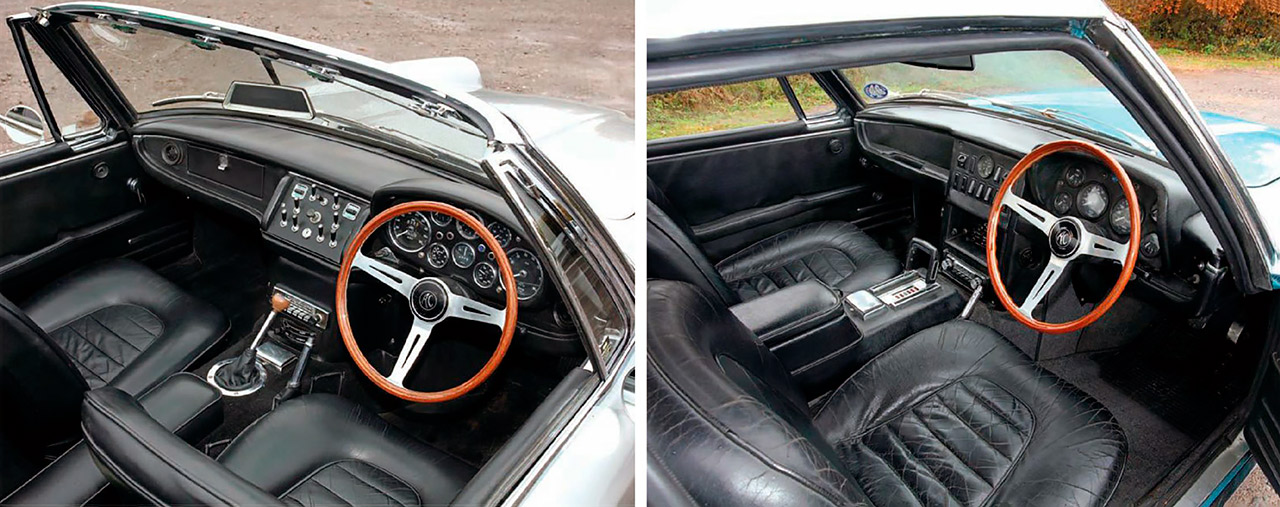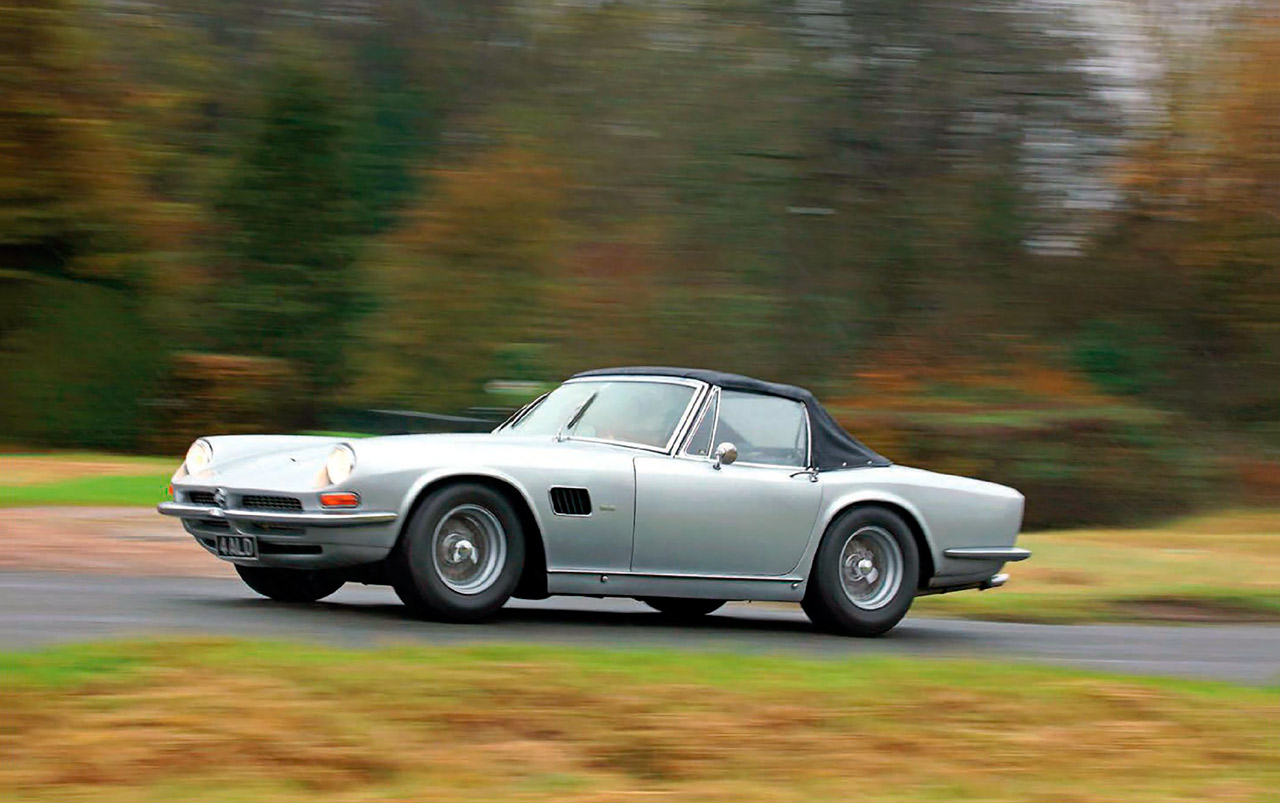
A Cobra for the jet set. AC’s other hybrid Buckley samples convertible and fastback variants of the unsung 428. AC’s rare 428 blended savage power with beautiful Italian styling. Martin Buckley tries Convertible and Fastback – and falls in love. Photography James Mann/LAT/Rex Features. 428: AC’s unsung hero is it better than a Cobra?
‘THE 428’S MESSAGE WAS ONE OF UNFETTERED PERFORMANCE, WITH CIVILISATION AS A BONUS’

Spacious cabin is packed with dials – note heavily cranked gearlever. Below right: unburstable Ford V8 offers immense torque and a great soundtrack. Luxuriously trimmed Fastback interior lacks some of the charm found in the Convertible. Below: huge powerplant sits well back in the engine bay.
The trend towards Euro-American hybrids had almost peaked by the time that AC got its act together with the 428 in the late 1960s. The moment had passed: Jensen seemed to have cornered the market for such cars, with Bristol and others mopping up the leftovers. Gordon-Keeble, meanwhile, had shown what happens to a car priced too timidly to attract buyers, who (rightly or wrongly) equate high prices with excellence. Perhaps uniquely, the GK flunked because it was too cheap.
The AC 428, never a cheap car, turned out to be rarer than the Gordon-Keeble. In many ways, it was not the glossy international GT hot rod that its mongrel CV seemed to imply. More than just a pretty face – and an off-the-shelf, reliable, lusty engine – the 428 idea had built-in credibility because it was a direct extrapolation of the most famous American-engined, European sports car of all: the competitionproven, coil-sprung, big-block Cobra.
Six inches longer in wheelbase than its forebear, here was an attempt to make a Grand Tourer out of perhaps the world’s most uncompromisingly aggressive roadster, rather than re-engineer ponderous saloon components into a businessman’s express with sporting aspirations. Yes, it would come with the automatic gearbox and electric windows that were expected by the carriage trade customers at which it was aimed.
Yet somehow the AC 428 never pandered entirely to the luxury whims that complicated and compromised the GTs of the late 1960s and early ’70s, against which contemporary commentators struggled to compare it. With a price tag that was as ferocious as its acceleration, the 428’s message was one of unfettered performance with civilisation as a bonus, instead of the other way around.

The AC’s profile carries strong echoes of Frua’s Maserati Mistral, but only the quarterlights and doorhandles are shared between the two.
Always a two-seater rather than a half-baked 2+2 – why compromise luggage space with semiuseless back seats that would hardly ever get used? – the 428 weighed in at almost 500lb less than an Aston DBS or an Interceptor. That was the secret not only to its performance (0-60mph in 6 secs or less, 30-50mph in 5.5 secs) but also of its quite reasonable 17mpg fuel consumption. At least for those who resisted the temptation to open the second set of chokes on its fourbarrel Holley carb. I happen to think that it is the most desirable car that AC ever built. It certainly deserved to find more than 81 buyers – 51 Fastbacks and 30 Convertibles – over its traumatic seven-year production run.
AC Cars Ltd of Thames Ditton was, of course, a long-established marque rather than a glossy, short-lived invention of the 1960s. The company may have earned its daily bread out of building three-wheeled plastic invalid cars for the Department of Health, but it also had a 65-year history and a pedigree of producing high-quality, race-winning sports cars. You can find the 428’s origins in a number of places, but it seems that AC managing director Derek Hurlock was thinking about producing a more refined version of the 289 long before the contract to build cars for Carroll Shelby looked as if it was going to come to an end. Keen to avoid another debacle on the scale of the Greyhound, Hurlock understood that Italian styling was the way to go in the mid-’60s.
As early as 1964, there were reports of a new AC being spotted in the paddock at Le Mans, but the slightly awkward, homespun looks of the prototype MA200 were not the answer. The 428 idea really came to life at the Geneva Salon in 1965 when Hurlock, encouraged by his Swiss agent Hubert Pathey, went shopping for bodywork for what would be the first AC model to be styled by an outsider.

From above: fuel filler blends into C-pillar; small luggage shelf – 428 was always a strict two-seater; Fastback on test at MIRA with Autocar – handling remains nicely composed through all types of corner. From above: familiar badge of the renowned Thames Ditton marque; toggle switches were ditched for the later Fastback; English ambience meets Italian style and Detroit muscle.
Bertone was approached but didn’t have the capacity to produce any more bodywork. Pietro Frua’s response was more positive: he promised Hurlock a running prototype by the end of the year. An extended Cobra chassis was sent to Turin in May 1965 and the finished car – a plumcoloured Convertible (chassis number CF1) – was displayed at Earls Court in October.
It wasn’t really finished because there was still work to do on tyre sizes and damper settings, mainly to take account of the heavier bodywork. In fact, that prototype, which would find TV fame as Tara King’s car in The Avengers, had alloy coachwork – with a metal cover over the hood that the production Convertibles didn’t have – a smaller 6.2-litre engine and quicker-ratio steering than the production 428s. Those didn’t come on stream until a year later, complete with mainly steel panels that didn’t need so much inner supporting structure.
The first six examples had the relatively exotic 427cu in Ford V8 but after that the lowerpowered, lower-revving and much cheaper to buy 428 with hydraulic tappets was settled upon. As found in various Galaxies and Thunderbirds, it cost roughly half as much as the crossbolt crank 427, which was in short supply anyway.
AC sent the rigid chassis of 4in tubes out to Turin on slave wheels and Frua turned them around at the rate of one or two a month. They then returned to Thames Ditton, where AC fitted the drivetrains and interiors, stove-enamelled the chassis, tried to sort out some of the poor Italian welding (428s always had a rust problem) and had the chroming re-done locally.
There was a choice of 14 body colours, with black, red or cream leather (most were black) and chromed 72-spoke Borrani wires or Minilite alloys. Avon tyres were settled on after it was found that Dunlops made the steering too heavy and that Michelins were good in the dry but not the wet. The Ford ‘toploader’ four-speed manual was standard (the first three cars were manual Convertibles), with the C6 three-speed auto as a £163 option running the higher 2.88:1 differential. In the end, automatic 428s would outnumber manuals by two-to-one.
At first, there was talk of offering as an option a 400bhp version of the V8 with solid tappets that would allow higher revs – the hydraulic tappets ‘pumped up’. But 345 gross American horsepower and 145mph was deemed enough in what was probably the fastest-accelerating true road car that you could buy at the time.
The 428 would be the last car that Frua built in his own workshop and, in truth, he had the contract to produce only the first 50. It was an absurdly expensive and time-consuming process and Hurlock, who did much of the development driving in the 428, was always hopeful that he would find a British coachbuilder.
He got close to a deal with Coventry Motor Panels, and there were even early thoughts of doing the shell in glassfibre. In the end, though, it was the lack of an affordable and logistically sensible source of bodywork that was the reason – but not the only reason – for the 428’s demise.
In 1968, however, there was still enough faith in the 428 concept to introduce a coupé or Fastback version at the Paris Salon. It seems that this is the point at which the project gained some momentum. Press advertising appeared – often in Country Life, which says something about the traditional AC clientele – and full-blown roadtests of the closed car in both Autocar and Motor.

Clockwise, from left: flowing lines brought AC styling up to date; Canadian actress Linda Thorson as Tara King in The Avengers, complete with 428; visibility is excellent in both variants.
By the end of ’1969, it was reported that AC had built 60 428s with a six-month waiting list and was allegedly making them at the rate of two a week – when they could get the bodies from strike-bound Italy. Buyers included Formula One privateer Rob Walker, who replaced his Facel II with a Convertible 428 (he had problems with it overheating) and The Who’s drummer Keith Moon, who had a late Fastback.
Moon didn’t have a licence but would drive the car when the mood took him, taking over the wheel from his long-suffering chauffeur – sometimes with disastrous results – but always leaving his driver to take the blame.
All the time, AC was working through development problems centred around irritating details such as the lack of footwell ventilation, overheating in traffic and loss of oil pressure at sustained high revs; twin electric fans and an oil cooler addressed those issues. Splined driveshafts and rubber bushes – replacing balljoints – cured clonks from the rear suspension. As for tyres and damper settings, the definitive solutions were left in the hands of later owners. In fairness, with a workforce of 150 and just four dealers, AC was a tiny operation that still prided itself on personal service. It was able, for instance, to tune the 428’s ride and driving position to individual buyers’ tastes.
From 1970, deliveries from Frua were ever more erratic and, in the days before we’d joined the EEC, buying bodywork from Italy had tax implications that kept the price of the 428 high – a vicious £7010 by 1973, easily enough for two E-types. It wasn’t the pricing or the oil crisis that killed off the 428, however, but Ford. When it announced that it would no longer supply engines direct to AC but only via a local agent, Hurlock decided that he’d had enough. The last 428 was built in July 1973, although there were nine outstanding orders from HR Owen.
The 428 was one of Hurlock’s favourite cars. He ran one himself for years but was probably wise in abandoning the idea of the 429, a fourseater coupé design that Peter Monteverdi rejected after his fall-out with Signor Frua.
If you are going to be greedy and own two AC 428s, then Adrian Dawn has the ideal combination of a manual Convertible and an automatic Fastback. The open car, chassis CF17, is, believe it or not, the 17th 428 built, delivered new in May 1969. Chassis CFX73 is one of the last Fastbacks, constructed late in 1972 or possibly early ’73. Dawn also has one of the five 428s that were converted into Cobra replicas – “In the days when 428s weren’t worth a lot,” he says with a grin. One further car (CFX18) was transformed into an Aceca ‘special’ out of a wrecked 428.
The uninitiated might take these cars to be Maseratis and it’s true that the basic shape was heavily influenced by Frua’s Mistral, though they shared only doorhandles and quarterlights. The Mistral is a pretty car, yet the 428 has a bullish machismo of its own (enhanced on Dawn’s cars by subtly wider Borrani wires) like a musclebound athlete in a close-fitting suit.
At the front, the V8 is crammed into the engine bay and you can see how it might have struggled to get airflow, although Dawn says that neither car has overheating issues. At the rear, both variants have deep, square boots, twin tanks and twin fillers. Brimmed to 18 gallons, they made the 428s quite decisively tail-heavy.

AC 428 – Convertible road test
The hood on the Convertible is easy to lower and, with no particular sill to negotiate – the chassis tubes are well inboard – getting into either car is easy. The ’69 Convertible has the prettier fascia, with eight chrome-bezelled instruments in a handsome binnacle and a rash of ‘Guinness bottle’ toggle switches on the centre console. The late Fastback has the post- 1970 Federal dash with a similar instrument arrangement but cheaper-looking rocker switches that feel vague when prodded. Hurlock was very tall so the driving position takes all sizes, the only oddities being the slightly offset pedals and the way that the long gearlever in the manual cants forward. There’s loads of glass area in the Fastback so views out are wonderful – or they would be if it didn’t mist up so easily in the rain that beset our photoshoot.
Low-slung and long in the bonnet, both have a decadent burble that would bring out the cad in anybody; a lazy sound somehow out of phase with the epic acceleration that is just a caress away. In 1966, the 428 must have given new meaning to the word ‘effortless’. Manual or automatic gears seem irrelevant in these brawny but docile machines. In the manual, you can’t push the shift hard or move it fast but, somehow, it goes through smooth and positive every time. Surprisingly, the clutch isn’t particularly hefty. First is quite long but really this car isn’t fussed which gear you pull away in. Just as AC advertised, it will cheerfully take fourth from 15mph without a shudder, drawn seamlessly away on the silken pulse of eight high-compression pistons.
In a way, the automatic, with the hooped or inverted horseshoe-shaped selector, is even more impressive, more in the spirit of what the 428 was about. Squeeze its throttle with any sort of meaning and the coupé just romps away in one great, linear lunge with only minor alterations in engine note to indicate gearchanges. It’s a feeling of such dominant, fascinating power that I don’t think I would ever get tired of it or immune to it.
There is no drama in what could easily have been a hooligan’s car. Both will chirp their rear wheels but the limited-slip differentials keep everything lined up as the car – automatic or manual – obediently turns torque into horizonchomping forward thrust.
With a chassis engineered for anti-squat and anti-dive (and running just about the widest tyres you would have found on any car in the late 1960s and early ’70s), both Fastback and Convertible feel totally at ease and entirely stable. Curves, crests and bends of either the strung-out or bunched-up variety present the flat-cornering, neutral-steering 428 with no difficulties. The ride is mildly vintage but the Convertible is as free from rattles and scuttle shake as the Fastback. You don’t get much lock for parking, but I didn’t consider the lively unassisted steering unduly weighty in either car.
The AC 428 was, in some ways, a machine born out of its time. Drive one and you feel that it is a vehicle more in the raffish 1930s image of a Railton, a Brough Superior or a low-chassis Invicta than the ’60s jet-set machine that its suave Frua styling suggests. It has muscles and elegance, and is at once a car for both the moustache-twirling bounder and the squarejawed hero. Once sampled, it leaves an impression that takes days to fade and it might just be my new favourite car.
To date, 61 of the original 81 428s are accounted for and they are seldom parted with. Factoring in the Cobra replicas and the lost-inaction 1970s write-offs, that’s still a handful unaccounted for, so there’s hope yet…
TECHNICAL DATA AC 428
Sold/number built 1966-’1973/81 (51 Convertibles, 30 Fastbacks)
Construction tubular chassis with welded steel body
Engine all-iron, pushrod, 7014cc 90º Ford V8, four-barrel Holley carburettor;
Power and torque 345bhp @ 4600rpm; 462lb ft @ 2800rpm
Transmission Ford toploader four-speed manual or C6 three-speed automatic, driving rear wheels via a Salisbury Powr-Lok diff
Suspension independent all round, by double wishbones, coil springs and Armstrong telescopic dampers
Steering rack and pinion
Brakes Girling discs with twin servos
Wheels and tyres 72-spoke Borrani wires, 205-15 radials
Length 14ft 8in (4470mm)
Width 5ft 7in (1702mm)
Height 4ft 3in (1295mm)
Wheelbase 8ft (2438mm)
Weight 3143Ib (1425kg)
0-60mph 5.9 secs
Top speed 145mph
Quarter-mile 14.2 secs
Mpg 14-18
Price new £5573 (’1968)
Now £100,000+
{module AC 428}





